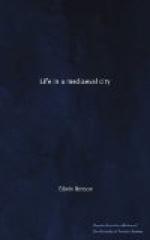The influence of such a monastery as St. Mary’s was very far from being restricted to affairs within the abbey walls. Through its Abbot it had a spokesman in the House of Lords. There were cells dependant on the abbey and often at a distance. The Abbot had a number of residences in the country and one in London. The abbey itself had numerous possessions of land and manors in many parts of the country. This was a principal source of revenue. St. Mary’s Abbey also had jurisdiction over many churches, not only in York and Yorkshire, but in other counties as well. The other monastic institutions and the Minster and some of the hospitals, for example St. Leonard’s, had similar rights of jurisdiction and the ownership of land, property, and churches.
In some of the churchyards there lived anchorites, anchoresses, and hermits. These were individuals who chose to live a solitary life spent in prayer and religious work. Anchorites led a life of strict seclusion, for they were literally shut in their cells, from the world. They did not, however, eschew all intercourse with others, for their solitary lives of devotion, and in some cases of study, gave them a reputation for wisdom that led people to seek them for their advice. Permission was given by the Church authorities to those who took up this mode of life, the assumption of which formed part of a special service. The Pontifical of Archbishop Bainbridge, who held the see from 1508 to 1514, contains an office for the Enclosing of an Anchorite. Hermits lived in less strict seclusion. Their aims were similar, but they went about in the world doing good works.
One of the worst features of the religious decadence of the Middle Ages was the craftiness of such spurious types of men as those whom Chaucer painted in the Pardoner and the Somonour, and Charles Reade depicted in the peripatetic “cripples” of “The Cloister and the Hearth.” Chaucer wrote in the true spirit of comedy mores corrigere ridendo, but Langland, his contemporary, who described similar types of men of State as well as of Church, did so from the point of view of a moral reformer whose satire is a trenchant weapon.
There were many other types of religious men, but it must suffice to refer to Pardoners, who by virtue of papal bulls gave pardons, expecting, exacting if necessary, a reward in return, and to mention only palmers and pilgrims, who were seen in York when they came to visit the shrine of St. William in the Minster. The palmers were pilgrims who had visited the Holy Land. They liked to wear a scallop-shell in their broad-brimmed hats as a sign of their extensive travels. Journeying from shrine to shrine was a favourite occupation, a professional one, of those pilgrims who loved a wandering and easy life, seeing the sights and living at the expense of the monastic hospitality. Some pilgrimages were done by proxy, through the employment of professional pilgrims. A pilgrimage to a shrine celebrated




